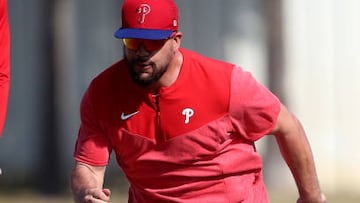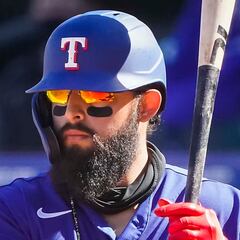Why banning the shift won’t help Kyle Schwarber hit any better
While fans of the Phillies powerful pull hitter Kyle Schwarber are rubbing their hands with glee at the thought of the shift ban, it probably won’t make much difference


The Phillies have a wonderful hitter in Kyle Schwarber. While his average doesn’t jump off the page at .233, he provides a level of home run power not traditionally seen at the top of the order. The acquisition of Trea Turner has bumped Schwarber out of his lead off spot, but even for a number two, he packs power.
Fans of the Phillies juggernaut, as well as other pull-prone hitters around the league, are rubbing their hands with glee at the prospect that Schwarber will translate that extra real estate into more base hits. Unfortunately, they are likely to be left disappointed.
Even the Phillies left fielder is mistaken on the issue. “It’s going to be a game of contact now without the shift,” says Schwarber. “You’re going to get rewarded. You’re not looking over at the right side and seeing four guys. That’s a good thing, it’s going to promote contact. And I need to improve on the strikeouts. Last year’s strikeouts, that was way too many. It’s something that I’m consciously trying to do.”
No National Leaguer last season faced a defensive shift more often than Kyle Schwarber, who is focused on reducing his strikeouts in 2023 to make better use of the new rules.
— NBC Sports Philadelphia (@NBCSPhilly) March 1, 2023
"It's going to be a game of contact now."https://t.co/cT2XjDZ5Oe
The problem with all of this is that baseball has always, yes always, been a game of contact. If you couldn’t make contact before, moving a player to the left or right of the second base bag won’t change that.
Shifting the infield was simply a tool that was used to maximise defense, but it certainly isn’t the only tool that teams used against hitters like Schwarber. The first tool is pitching. And Scwharber has a gaping hole in his swing.
If you are pitching to Schwarber, you throw everything high, everything tight, paint around the edges of the plate, but don’t give him anything low and away. His best hope is to take walks, and that is fine. Give him the walk.
You see, Kyle Scwarber has 918 career strikeouts and only 22 stolen bases. That is terrible. The Phillies have traded reliability for power, and generally it has been a good trade for them. But Scwharber is not a threat to you on first base. And if you keep the pitches close enough to the plate, you stand a decent chance of striking him out. Shifted infields won’t help much.
Kyle Schwarber said after a short offseason, the Phillies are ready to get back after it following the team's first full-squad spring workout: https://t.co/gtquXs5e3d pic.twitter.com/EJxjVvrO0o
— CBS Philadelphia (@CBSPhiladelphia) February 22, 2023
If Schwarber can manage to put the bat on the ball with more frequency, perhaps the situation will be different. Phillies manager Rob Thomson certainly thinks so. “He’s trying to. That’s one of his things, put the ball in play. He doesn’t want to eliminate home runs per se but he does want to make more contact and by the time we’re out of spring training, I think he will.”
Related stories
Maybe Kyle Scwarber will learn how to hit in the next month. Maybe.
Baseball has always been about contact, and until Schwarber shows that he can do something other than occasional bursts of power, pitchers shouldn’t give him anything to hit.

